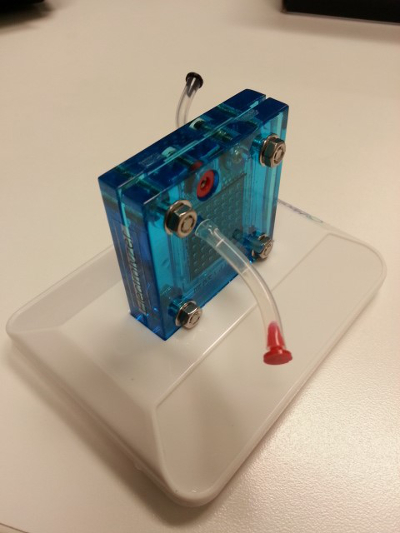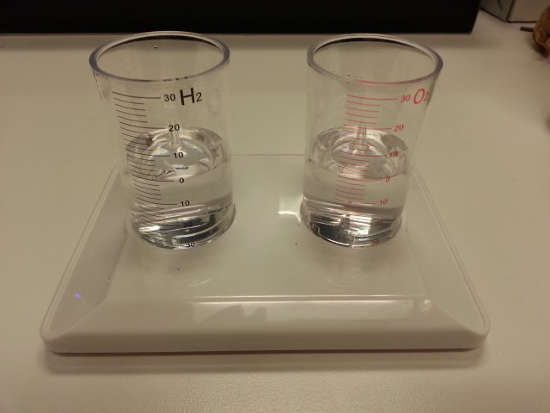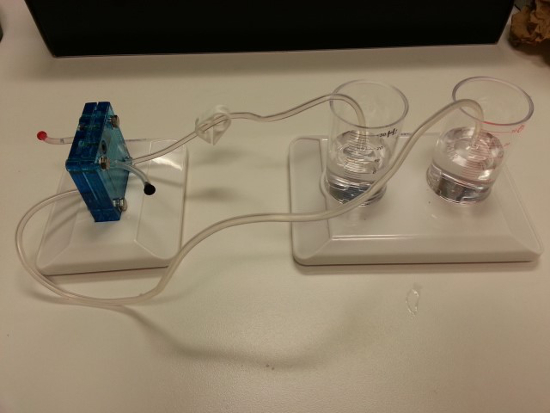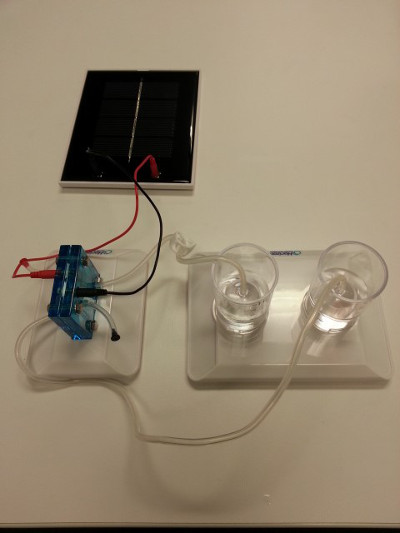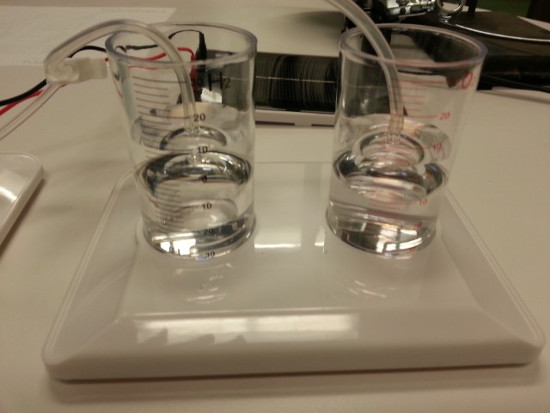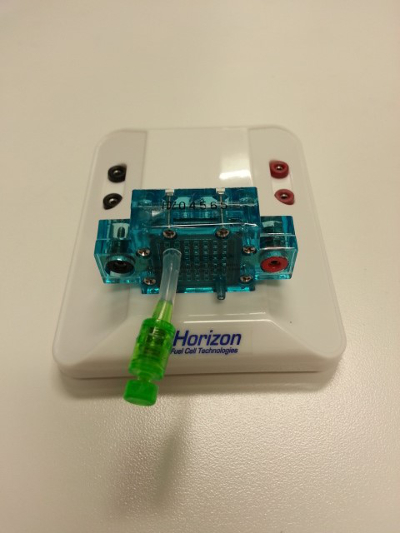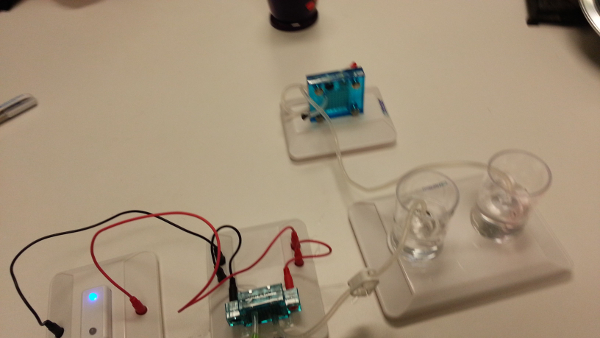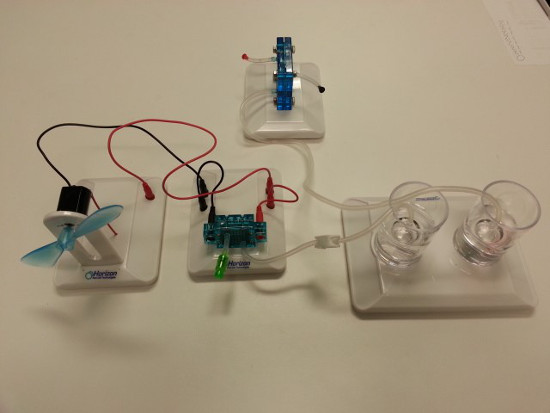プロトン交換膜燃料電池
概要
マーガレット職人とキンバリー ・ フライ - デュポール大学のソース: 研究所
米国は、大量のエネルギーを消費する-現在のレートは年間約 9 京 7500 兆 btu 単位。このエネルギーの大半 (90%) は非再生可能燃料の源から来る。このエネルギーは電気 (39%) の使用、住宅/商業、産業 (22%)、交通機関 (28%) 使用 (11%)。世界は、これらの非再生可能エネルギー源の限られた供給は、(その他) の中でアメリカ合衆国は将来のエネルギー ニーズに合わせて再生可能エネルギー源の利用を拡大しています。これらの源の一つは水素です。
それは多くの重要な基準を満たしているので、水素が潜在的な再生可能な燃料源と見なされます: 国内利用可能だ、それは、いくつかの有害な汚染物質、エネルギー効率、およびそれの簡単なハーネスします。水素は宇宙で最も豊富な要素が、唯一地球上で複合形式であります。H2o. として水の酸素と組み合わせるなど、燃料として役に立つには、それは、H2ガスの形でする必要があります。したがって、水素車または他の電子機器の燃料として使用する場合は、H2は最初にされる必要があります。Thusly、水素と呼ばれます「エネルギー キャリア」ではなく、「燃料」です。
現在、H2ガスを作る最も人気のある方法は、炭化水素や石炭ガスの水蒸気改質反応によって、化石燃料からです。これは化石燃料への依存を減らさないし、エネルギー集中であります。水の電気分解は使用頻度の低い方法です。これも、エネルギー源が必要ですが、それは風や太陽光発電などの再生可能エネルギー源をすることができます。電解で、水 (H2O) は、電気化学的反応により水素ガス (H2) と酸素 (O2)、その部品に分割されます。電解プロセスを通じて行われた水素ガスは、プロトン交換膜 (PEM) 燃料電池で、電気電流を生成する使用できます。この電流は、モーター、ライト、およびその他の電気機器の電源を使用できます。
手順
1. 水素ガスを生成するのにこの電解槽を使用
- 電解槽 (図 3) をセットアップします。
- ガスボンベ コレクションを設定すると、0 のマーク (図 4) では外筒に蒸溜された水のレベルを確かめます。
- この電解槽をガスボンベ コレクション (図 5) に接続します。
- ジャンパー線を用いた電解槽に太陽電池パネルを接続し、直射日光 (図 6) を公開します。太陽をシミュレートする電球とランプを使用して、その日を天気が協力していない場合に注意してください。
- H2と O2ガスが内筒 (図 7) を入力を開始されます。モニター 30 の間隔で各ガスの容積生産のスケールを使用して外側のシリンダー上のマーク。H2ガス内筒いっぱいに約 10 分かかります。
- 内筒は、H2ガスの完全
結果
申請書と概要
タグ
スキップ先...
このコレクションのビデオ:

Now Playing
プロトン交換膜燃料電池
Environmental Science
22.2K 閲覧数

樹木: 二分のキーを使用するには、方法
Environmental Science
81.4K 閲覧数

点を中心とした樹木の調査: 四半期サンプリング
Environmental Science
49.5K 閲覧数

GIS を用いた都市林業を調査
Environmental Science
12.7K 閲覧数

バイオ燃料: セルロースからのエタノールの生産
Environmental Science
53.4K 閲覧数

組み換え食品の遺伝子検査
Environmental Science
90.1K 閲覧数

濁度と地表水の全固形物
Environmental Science
35.9K 閲覧数

水中の酸素を溶存
Environmental Science
56.0K 閲覧数

水生生物の生態系の栄養素
Environmental Science
39.0K 閲覧数

対流圏オゾンを測定
Environmental Science
26.5K 閲覧数

紫外可視分光法を用いた自動車の排気ガスのないxの定量
Environmental Science
30.3K 閲覧数

原子吸光分光法による土壌の鉛の分析
Environmental Science
125.9K 閲覧数

炭素・窒素環境試料の分析
Environmental Science
29.6K 閲覧数

土壌養分分析: 窒素、リンおよびカリウム
Environmental Science
216.2K 閲覧数

土壌にミミズ個体数の解析
Environmental Science
16.6K 閲覧数
Copyright © 2023 MyJoVE Corporation. All rights reserved
